“I have a British background and I have always had tea and something sweet. First time I tried this clotted cream I almost ate the entire jar by itself, it is that good!” ~Kim

If you’ve never had a classic English afternoon tea with scones and clotted cream, you’re missing out!
Last week I was treated by the historic Biltmore Hotel in downtown Los Angeles to their classic English afternoon tea. If you’ve never had a classic afternoon tea, you need to experience it. The highlight of any afternoon tea, besides the tea, is the array of tiny treats that comes with it, and I always zero right in on the scones and clotted cream. (That’s them on level two of our 3 tiered tea tray.)

What is Clotted cream?
If you’ve never had it, clotted cream is a very thick rich spreadable form of heavy cream that was first invented ages ago by some very smart British farmers. Traditionally cream heated until it thickens and develops a slightly nutty flavor. Clotted cream has a high fat content (around 55-65%) and a dense texture. It’s not like whipped cream, or cream cheese, it’s not like butter…it has a unique decadent consistency and a wonderful soft flavor. It’s quite thick and spreadable, and when you slather it on a freshly baked scone there is no better thing in the world.
The little pot of clotted cream that we got at the Biltmore had me craving more, and happily I made the most astounding discovery…you can actually make clotted cream at home in your own kitchen. No more tracking it down in specialty stores and paying big bucks for the imported stuff. My homemade clotted cream was actually way better (and a whole lot fresher) than the British stuff I usually buy.

What does clotted cream taste like?
Clotted cream has a rich, creamy taste with a slightly nutty ‘cooked’ flavor. It’s luxurious and indulgent, with a dense, velvety texture that is thicker and creamier than regular whipped cream. Clotted cream is also slightly sweet, but not as sweet as whipped cream or frosting, with a delicate flavor that pairs well with desserts, fruit, and scones. The crust on top of the clotted cream adds a slightly caramelized and nutty flavor, which many people find particularly delicious. The mouthfeel of clotted cream is a key part of its charm, and is like nothing else you’ve ever had!
what you’ll need
- heavy or whipping cream that has not been ultra-pasteurized
- This is cream that has been pasteurized, but not ultra-pasteurized. Ultra-pasteurized cream is cream that has been heated to a higher temperature than regular pasteurized cream to extend its shelf life.

How to make clotted cream
This is an amazing process, I hardly had to do anything, and I end up with a ton of the richest, silkiest clotted cream I’ve ever had.
- I used 2 pints of (non-ultra-pasteurized) heavy cream.
- I poured them into a baking dish, and left it overnight in a 180F oven (the lowest my oven will go.)
- In the morning I let it cool and then refrigerated it for the rest of the day.
- Then I scooped it into jars, which was a little sloppy at first, and put them back in the refrigerator. Any little bit of liquid gets absorbed right into the clotted cream after you put it in the jars, and by the next morning when I had it with my scones, it was absolutely to die for.
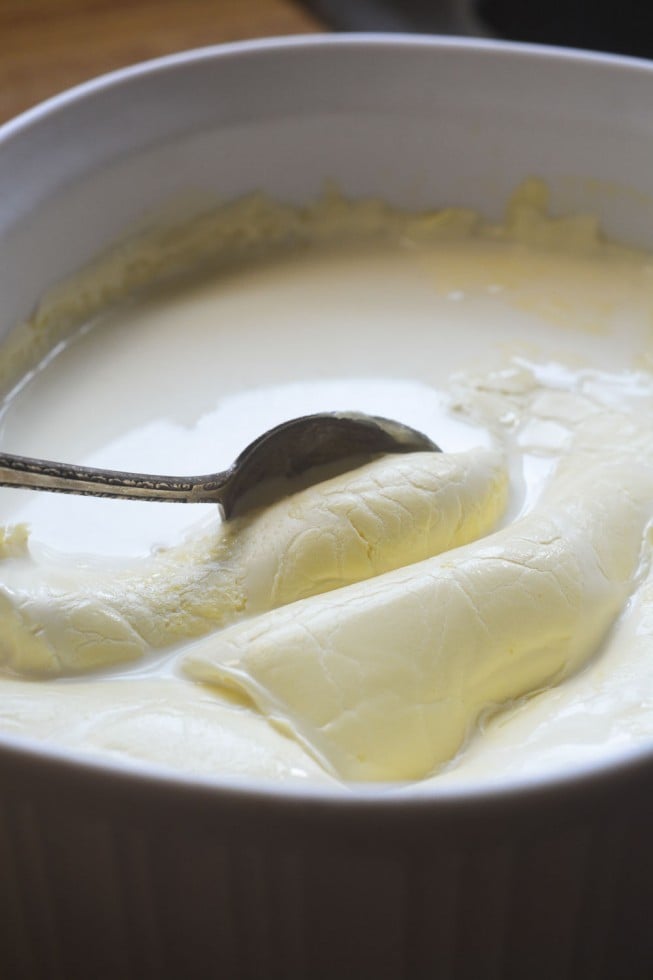
How long does clotted cream last?
Homemade clotted cream can last for up to 3-4 days when stored properly in the refrigerator. To extend its shelf life, it’s important to keep it in an airtight container and store it in the coldest part of the refrigerator, such as the back of the bottom shelf.
It’s important to note that clotted cream does not have any preservatives, so it should be consumed as soon as possible for the best flavor and texture. If you notice any changes in color, texture, or odor, discard the clotted cream immediately as it may have spoiled.
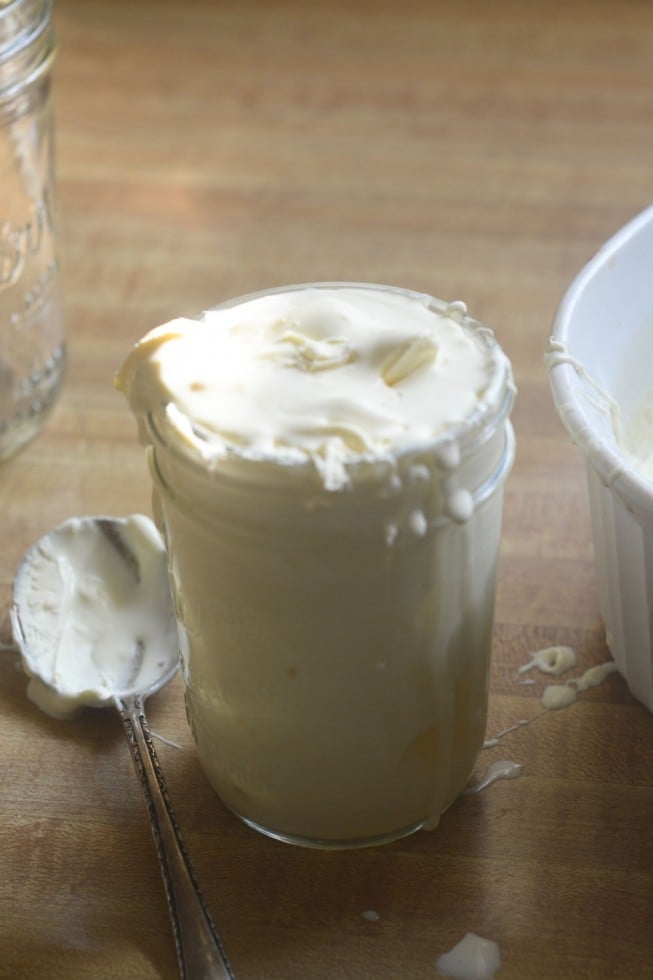
What to do with the leftover whey from making clotted cream
The leftover whey from making clotted cream can be used in a variety of ways:
- Adding it to smoothies or protein shakes for a boost of protein and nutrients.
- Using it as a substitute for milk or water in baking recipes such as bread, muffins, and pancakes.
- Using it as a marinade for meat or fish to tenderize and add flavor.
- Adding it to soups or stews for added richness and flavor.
- Using it as a liquid base for making homemade ricotta cheese or other soft cheeses.
- Feeding it to pets, as it is a good source of protein and nutrients for animals.
Note: It’s important to keep in mind that the leftover whey should be used or stored promptly to avoid spoilage. It can be stored in the refrigerator for up to a week or frozen for longer storage.
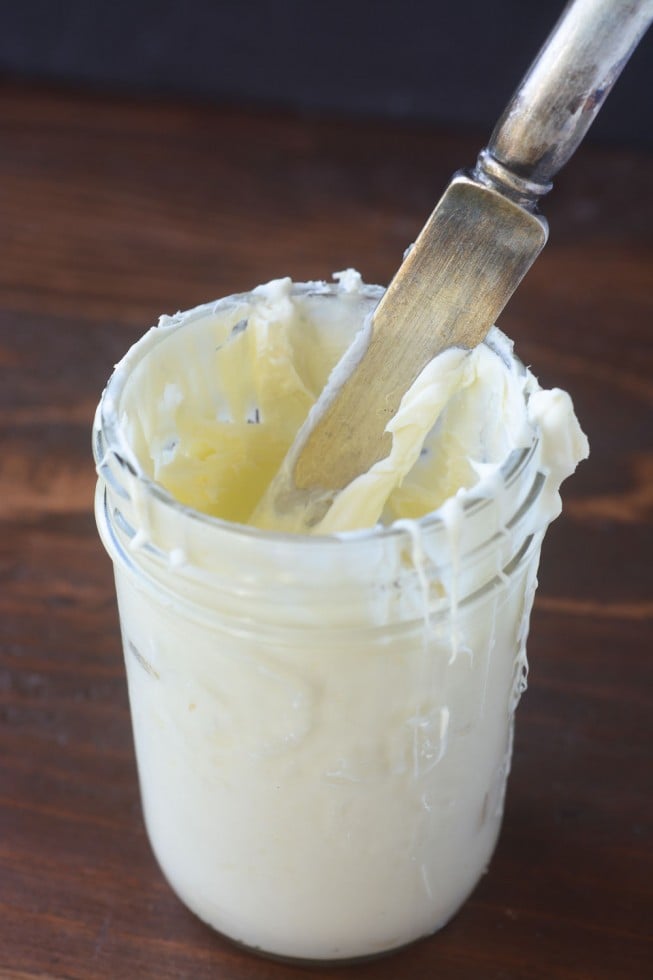
I can’t say enough good things about this project, the results far exceeded my expectations and it was absurdly easy. The only catch is that you can’t use ultra-pasteurized cream, which is cream that’s been processed for a longer shelf life. Many stores only sell ultra-pasteurized cream, so you have to search a bit for regular cream. I found mine at Whole Foods. Just read the labels… if it doesn’t say ultra-pasteurized on the label, you’re good to go.
can you make clotted cream with ultra-pasteurized cream?
Some readers in the comments below have had success with ultra-pasteurized cream. It is possible to make clotted cream from ultra-pasteurized cream, but it may be more difficult to achieve the desired texture and flavor. Ultra-pasteurization is a process that heats the cream to a higher temperature than regular pasteurization, which extends its shelf life but can also alter the proteins and enzymes in the cream. This can make it more difficult for the cream to form clots, which are necessary for making clotted cream.

What to eat with your homemade clotted cream
You will definitely want to make scones to go with your homemade clotted cream. I have lots of recipes for scones on the blog, but a simple one to start with is my Classic Cream Scones Recipe.
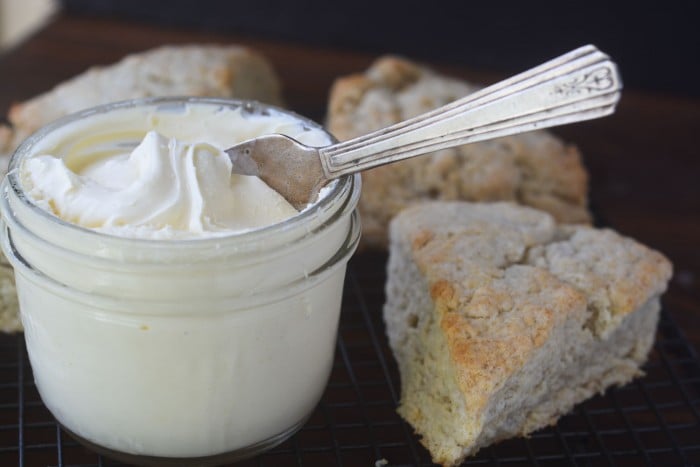
Tips for making clotted cream
- Make sure your cream is not ‘ultra pasteurized’, you will need to find regular pasteurized cream at a Whole Foods or other similar store. Ultra pasteurized cream has been treated in a way that prevents it from ‘clotting’.
- An oven thermometer is an essential kitchen tool, and really comes in handy for this project. If your oven is too cool or too hot your homemade clotted cream will not ‘clot’. Set your oven to 180F and then check the thermometer. You can adjust up or down as necessary.
- If your oven does not go down as low as 180F you can try one of my other methods for making clotted cream:

Homemade Clotted Cream
Video
Equipment
- a heavy casserole dish
Ingredients
- 2 pints heavy cream or whipping cream (double cream in the UK), avoid ultra-pasteurized cream for best results.
Instructions
- set your oven to 180F
- Pour the cream into the casserole dish. It should come up about 1-3 inches on the side.
- Set the dish, uncovered, in the oven and leave undisturbed for 12 hours. Be sure to leave the oven on the whole time. I do this overnight.
- Remove the dish from the oven and set to cool. Then cover and refrigerate. Note: the cream may seem thin at this point, but is going to thicken considerably overnight.
- The next morning scoop the thickened cream into a jar or jars, and cover and put back in the refrigerator. You can use the leftover cream for baking..
- Spread the clotted cream on freshly baked scones.
Nutrition


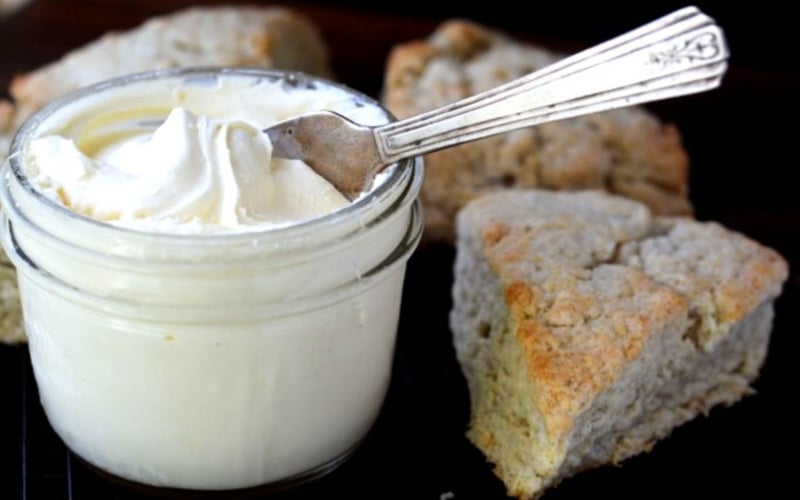




















Hi I made the clotted cream using 2 pints of cream , after separating it I still have 1 pint of cream which is the same consistency as the double cream I used at the beginning, can I use this to try making more clotted cream or is this a food safety issue ?
I’m not sure it would work to re-clot it, Lorna, but you can certainly use the cream within a few days for baking. I suggest making scones!
Hi
Can you make this in the Instant Pot on the yogurt setting .
Thanks
Arlene
Yes, here’s a link to my new post about making clotted cream in the Instant Pot, it works great, just follow the instructions exactly! https://theviewfromgreatisland.com/instant-pot-clotted-cream-recipe/
What do you do with any leftover thin,milky cream? Can it be used for baking scones or biscuits?
Yes, absolutely. Use it in place of milk or buttermilk.
My clotted cream had a hard crust on top. There was clotted cream under it, but it was impossible to removed the hard crust. It’s not bad, but not smooth like your picture. What did I do wrong? I followed the recipe exactly.
There is supposed to be a crust on top, sometimes even pretty hard, that’s part of the clotted cream. One thing I’ve done when I get that is to take my stick blender and blend it up with the softer clotted cream, works like a charm, just don’t blend more than an instant.
Another thought is that your temperature was slightly too high, which might result in cream that got too ‘cooked’.
My first time making clotted cream
How long will it be good for after making?
Going to make some for a gift with a jar of jam and some homemade scones ??
It will last a couple of weeks, Linda.
Hi…how can I get on your mailing list? Don’t see a place to sign up…Debora
There’s always a sign up form on the right hand side of any page on my blog, Debora, and here’s a link for you
Thanks and glad to have you join me!
I made this overnight with 3 pints preparing for 18 people. I panicked after checking it in the fridge about 5 hours in. It was still pretty runny. I thought I failed. I called a local tea shop who made me an emergency cup off Devonshire. But I check it again before going to bed and it thickened and was wonderfully perfect! So we had both and I had about 1 cup left over to enjoy to myself! I think it tastier than the Devonshire, but that was my first taste of both. Thank you for an easy great recipe.
I love to hear these stories Sarah, this can be a little tricky but I’m so glad it worked out perfectly for you. I’m so glad you saved yourself a cup 🙂
Thank You for posting this! I will try this soon. How long does this last if there are leftovers?
It will keep for at least a couple of weeks, Jennifer, probably more.
Can you tell me the number of ounces of clotted creme that result from 2 pints of heavy cream? I didn’t know if there was a difference
It’s really going to vary, Melani, but you will get approximately a pint of clotted cream.
Does anyone have the recipe to make this in a crockpot? I think I use to leave the crockpot on warm for 12 hours?
I’ve tried it in the crock pot Cherie and it didn’t work because it was too hot, I believe the low setting is usually 200 for food safety reasons.
I make mine in the crockpot. I use the Keep Warm setting. I have a double batch going right now to make Clotted Cream Shortbread Cookies. ?
Hello! I am getting ready to make the clotted cream to go with the cardamom vanilla cream scones I will be making tomorrow.
I only have 1 pint of cream. Do I need to adjust cooking time? Will 1 pint yield enough for 1 batch of scones? Thank you !
I don’t think it will work with one pint Jackie, you need a certain volume of cream to have it clot. If you want to try, make sure to use a smaller container so your cream is about 2 inches deep. I’ve never done a smaller amount, so I’m not sure about the timing, sorry!
We LOVED your Victoria Sponge Cake recipe. If you have a good recipe for plain scones, I would love to try them. Plain has always been my favorite! Love your site. 🙂
Thanks Jackie! Now that I think about it, I don’t have a recipe for plain scones, but the scone recipe from Savory Simple that is in this post is very good, and you could leave out the cardamom.
They sound heavenly. Would you share your recipe please?